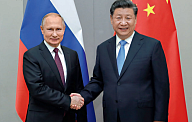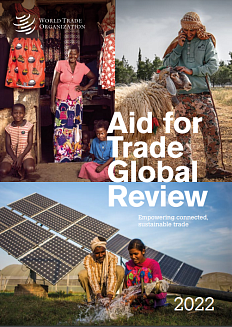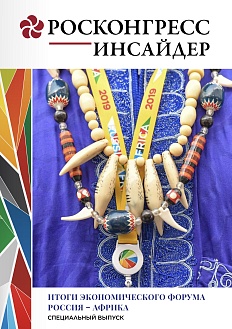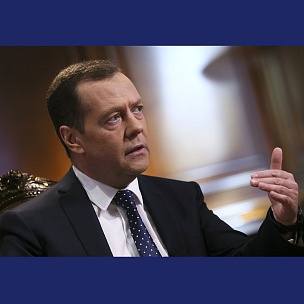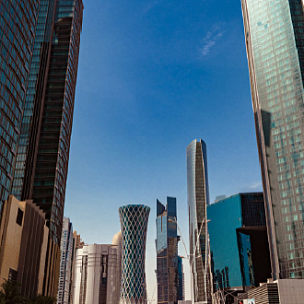Russia?s ?eastward turn? is not just a response to geopolitical challenges. We are witnessing the birth of a new multipolar world, in which Russia and the countries of the East will emerge as key players
The new global order, which people have been calling for so often in recent years, is finally taking shape. The wideranging sanctions imposed on Russia by the west have finally undermined all the foundations of the previous state of world affairs. Russia is finding answers to this unusual situation through import substitution, a push for technological sovereignty, a readiness to protect its vital interests, including by force and, of course, through economic cooperation based on clear, depoliticized and commonly accepted rules. This is why the eastward turn, or the reorientation towards friendly nations in the east, is a completely natural step for Russia and is set to bring a number of benefits and new opportunities in the near future.
The east supports Russia
It goes without saying that the eastward turn wouldn?t have been possible without a political foundation. It required the willingness of a number of eastern nations (almost all of them in fact) to continue their cooperation with Russia. There are many reasons why they have, but the key factor lies in the fact that the east simply doesn?t believe the west. The Global South, comprising countries in Asia, Africa and Latin America, realizes that it is not Russia which is threatening the global order. «They operate thousands of kilometres away fr om their territory under various pretexts, including the pursuit of their own security interests,» Russian President Vladimir Putin said, describing the strategies of western nations at a panel held by the Ministry of Defence of the Russian Federation. «When they are inconvenienced by international law or the UN Charter, they declare it obsolete and unnecessary, but when it suits their interests, they immediately bring up statutes of international law, the UN Charter and international human rights.»

A highly unpredictable policy environment creates significant demand for global security providers, and in this case the Global South is looking primarily to sovereign emerging economies such as Russia, China and India. The Shanghai Cooperation Organization (SCO), created on the basis of an initiative from Moscow and Beijing, is a prototype version of a security provider of this type. Two leading regional players, India and Pakistan, have already entered the SCO, and in the near future Iran, and possibly even Belarus, will join its ranks. Though some in the west hoped that the presence of countries with serious bilateral conflicts (such as India and Pakistan or India and China) would paralyse the organization, this has not been the case. Furthermore, having emerged as a purely political union created in order to provide collective security, the SCO is gradually expanding its economic reach. The annual meeting of the Ministers of Industry of the Shanghai Cooperation Organization, which launched in 2021 to boost cooperation on high-tech issues and oversee the creation of industrial parks and commercial and industry clusters in member countries, represents a new tool in the organization?s arsenal.

Moving on from the geopolitical dimension to the economic one, Russian companies have been working with Asian markets for a long time and intend to strengthen their cooperation. Between April and May 2022, the Eurasian Institute for the Study of Product Safety conducted a survey among importing companies, which showed that 95% of respondents were in favour of the eastward turn. «The competencies are there. Many goods were already being purchased from China, but they arrived in Russia after transiting through Europe,» says Ivan Lizan, director of the analytics office of the SONAR-2050 project. The issue lies with Asia itself. After all, in the current conditions wh ere the collective west is stubbornly imposing an ?us versus them? mindset on the world, eastern nations must have a sufficient level of sovereignty and political will in order to work with Russia. So far this will and sovereignty are being demonstrated, first and foremost, by the two Asian leaders: India and China.
Our democracy
The USA was confident that India, the world?s largest democracy, would join in with the condemnation of Russia and the economic sanctions imposed on Moscow, expanding their reach fr om the west to the whole world. New Delhi, however, saw an opportunity to deepen its cooperation with Moscow in several priority areas for India. At the same time, the countries have been able to bypass SWIFT by creating their own mutual settlements system. Russia?s side is based on the financial messaging system of the Bank of Russia (SPFS), which deposits roubles into the accounts of Indian banks, wh ere they are converted into rupees. India is using Chinese yuan, Hong Kong dollars, euros and UAE dirhams in mutual settlements, and has almost completely abandoned US dollars.
One major development is India?s decision to purchase large volumes of Russian oil. Russia is now the second largest supplier of oil to India after Iraq. New Delhi, meanwhile, can continue to increase imports while the country?s domestic market grows, and Europeans will be able to purchase Indian petroleum products made fr om Russian raw materials even after European sanctions on Russian oil have come into force. The weak link in this arrangement, which will require further attention, is transportation. Oil deliveries to India are fulfilled by tankers, but the marine logistics infrastructure is controlled by western nations.

Nevertheless, supplies of Russian coal are increasing alongside oil shipments. In the first quarter of 2022, coal deliveries grew to 570,000 tonnes. By the middle of the year Russia, represented by PhosAgro, had become the leading supplier of phosphate-based fertilizers to India, providing over a third of the country?s needs (350,000 of 980,000 tonnes in the first half of the year). Further to this, Russia expects that India will in future become a key market for gold, in the wake of G7 countries recently ceasing imports.
The economic ties between the two countries are not limited to the supply of raw materials and fertilizers, however. India intends to continue and deepen cooperation with Russia?s military-industrial complex. Moscow is the key supplier of weapons for the Indian army and, over the past decade, India has purchased USD 25 billion in weapons from the Russian Federation, compared with just USD 4 billion from the United States. From 2017 to 2021, Russia accounted for 46% of Indian arms imports. The Russian militaryindustrial complex is, unlike western nations, a sole-source supplier of sorts, since it allows India to produce military hardware itself, either under license or as part of joint production activities.
Russia hopes to receive not only Indian goods and technologies in its imports from India, but western ones too. «Indian companies are embedded in western technological chains. This means that the country has everything (or can acquire everything) that a domestic manufacturer basing its business on western solutions needs, up to and including components,» said Alexey Kupriyanov, Head of the Group on South Asia and Indian Ocean of the Institute of World Economy and International Relations (IMEMO) of the Russian Academy of Sciences. In any case, India itself has more than enough hightech competencies and enjoys a leading global position in the pharmaceuticals industry (accounting for 20% of demand and 60% of the global supply of vaccines). The import volumes for Indian medicines into Russia in 2021 (USD 600 billion) therefore have plenty of room to grow, especially in the context of a shortage of raw materials hindering Russia?s development of its own medicines.

Oil and more besides
The prospects for economic cooperation between Russia and China arguably look even more impressive. The Chinese economy can make use of Russian energy resources that were previously exported to other countries, as well as Russian agricultural products and other raw materials. China is now highly dependent on imports of raw materials (including oil) by tankers through the straits and along the coast of the Indian Ocean, which is to say through waters controlled by the US. Reducing this dependence is of course desirable, including by way of purchases from Russia.
Beijing?s needs are enormous. Russia produces around 10.5 million barrels of oil per day, of which 7 million are exported, while China imports 11 million barrels. Russia?s share of Chinese oil and gas imports currently stands at 16%, making it the largest supplier. In four months of 2022, Gazprom delivered 60% more gas to China than in the same period last year. This rate of growth relies on throughput capacity. «The Power of Siberia pipeline is not yet able to pump its full design capacity of 38 billion cubic metres per year, as the original plan sets out a period of several years for the pipeline to achieve its design capacity,» said lecturer at the Financial University under the Government of the Russian Federation and Lead Analyst of the National Energy Security Fund Igor Yushkov.

New compressor stations are however being built already, in addition to a gas pipeline from the Kovykta field, a secondary resource base. Gazprom is also holding discussions with China on the construction of a second gas pipeline from the West Siberian petroleum basin, which currently supplies gas to Europe. Finally, there is the possibility of supplying LNG in tankers, for example under the Yamal LNG project. Russia could theoretically increase gas supplies to China to 100 or even 150 billion cubic metres, and this is something Beijing is interested in.

Moscow, on its part, wants high-tech Chinese goods from electronics and semiconductors to cars and machine tools. Encouraging developments are being observed in this area too. According to the General Administration of Customs of the People?s Republic of China, semiconductor shipments from China to Russia shot up by 214% in the second quarter of this year and are maintaining a steady rate of growth. The total volume of Chinese exports to Russia increased by 18% year on year, as of July 2022. Technological cooperation can also be pursued in a scientific context. For example, researchers at the Far Eastern Federal University (FEFU), alongside their colleagues from the Shanghai Institute of Ceramics of the Chinese Academy of Sciences, are launching production on single crystals to improve the detection accuracy of X-ray CT scanners. This will also help to determine the extent of tissue damage in cancers with greater accuracy. The FEFU scientists are also cooperating with partners at the Institute of Physics of the Chinese Academy of Sciences. Through their work, Russian and Chinese specialists have discovered a new mechanism for controlling the magnetization of nanostructures using spin current. This development is an important step in the creation of the next generation of energy-efficient electronics. There are many similar examples of high-tech cooperation at other Russian research centres.

The key to economic development
Besides India and China, Russia is also developing its relations with other eastern nations, in particular Indonesia and Vietnam under the ASEAN framework. The categories of goods being traded are fairly standard and encompass the military, fuel and energy, and agriculture sectors. Russia is also petitioning for the signing of free trade agreements between the Eurasian Economic Union and the ASEAN countries, leading to a general trade agreement.
Moscow envisions cooperation with its eastern neighbours in a large part through the prism of the economic development of the Russian Far East, which has unique characteristics as a region. On the one hand, it has huge potential in terms of developing its natural resources, tourism and logistics (for example, it would be more convenient for north-eastern Chinese provinces to deal with the outside world via Russian Far Eastern ports than Chinese ones). The development of the Arctic also has a significant role to play in increasing investment attractiveness. On the other hand, the low population of the Far East makes it difficult to realize this potential without large-scale state support. This is why the Russian government has prioritized the development of the region in recent years and intends to invest even more. «Today, in a time when Russia is under sanctions, the government understands the value of the Far East. It is our storehouse, and it is here in the Far Eastern Federal District that the key to Russia?s economic development can be found. However, we need to improve standards of living in remote regions and address socioeconomic development,» said Nikolay Kharitonov, Chairman of the Committee for Regional Policy and Issues of the North and Far East, State Duma of the Federal Assembly of the Russian Federation.

Infrastructure has always been one of the areas wh ere the Russian Far East has lagged behind, and this is an example of a sector that the government is working actively to improve. Development is underway on global transport corridors including the Northern Sea Route, the Trans-Siberian Railway and the Baikal?Amur Mainline, which are set to become key logistics highways in relations with the east in the coming decades (see page 128). At the same time, attention is still being paid to new local projects. Over 100 new small aircraft will be built for local airlines in the Far Eastern Federal District. At present, there are only around 40 small aircraft in operation in the entirety of the Far East, some of which are already considered to have outlived their service life. Active efforts are of course underway to bring private investors into the Far East and Arctic. The national programme for the development of Russia?s Far East to 2025 and up to 2035, which was adopted in 2019, has already been significantly upgraded through government initiatives this year. Notably, a decision was taken on the possibility of issuing loans on preferential terms for projects that create at least 250 jobs, provided that they are completed to schedule. The government has allocated RUB 30 billion to this end, and it is hoped that 30,000 jobs will be created. Additionally, a recent decree expanded the advanced special economic zones (ASEZs) in Amur Region and Kamchatka, Transbaikal and Khabarovsk Territories. New construction projects being implemented include a mining and processing plant at the Kumroch deposit, a ship repair enterprise in Petropavlovsk-Kamchatsky (Kamchatka ASEZ, RUB 22 billion in private investments, 1,300 new jobs), a liquefied natural gas complex in Amur Region (Svobodny ASEZ, RUB 1.1 billion in investments) and a new residential quarter in Chita under the Far Eastern Quarter programme (Transbaikal ASEZ, RUB 36.2 billion in investments), as well as a project to modernize the sea terminal in the town of Okhotsk (Nikolaevsk in Khabarovsk Territory ASEZ, RUB 140 million).
The main goal of all of these efforts is to secure Russia?s technological sovereignty and sustainable development in the new multipolar world.


